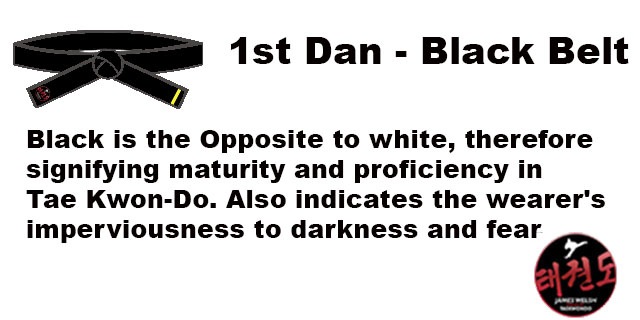New Stances
Parallel Ready Stance with Heaven Hand – Narani Chunbi Sogi Hanulson
One Leg Stance – Wae Bal Sogi
New Hand Techniques
Parallel Ready Stance with Heaven Hand (breaking into both forearm guarding block and Moa Chunbi Sogi B (Po Eun and Kwang Gae)
Slow Motion Middle Reverse Upset Punch – Kaunde Bandae Dwijibo Jirugi
Sliding Back Low Knifehand Guarding Block in LS – Mikulgi Najunde Sonkal Daebi Makgi
High Knifehand Guarding Block in RFS – Nopunde Sonkal Daebi Makgi in Dwit Bal Sogi
Palm Reverse Upward Block in WS – Sonbadak Ollyo Bandae Makgi
Low Knifehand Inwards Front Block (using the other palm as a focus point) in Closed Stance – Najunde Anaero Sonkal Ap Makgi in Moa Sogi
Downwards Side Fist in Closed Stance – Naeryo Yop Joomuk Taerigi , Moa Sogi
Back Fist High Side Strike in Sitting Stance Stamping Motion – Dung Joomuk Nopunde Yop Taerigi in Annun Sogi , Bapgi Sokdo
Foot Shifting into Double Forearm Block in WS – Jajunbal Gunnan Sogi Doo Palmok Makgi
Foot Shifting into a Low Outer Forearm Reverse Block maintaining other arm as before
Foot Shifting into a Flat Fingertip Thrust Slow Motion
Upwards Punch in one leg stance (bringing other fist to punching arm shoulder joint) – Ollyo Jirugi in Wae Bal Sogi
Sitting Stance Middle Turning Punch – Annun Sogi Kaunde Dollyo Jirugi
Sitting Stance Forefist Pressing Block with simultaneous Inner Forearm Middle Block in Fast Motion – Annun Sogi Ap Joomuk Noollo Makgi and An Palmok Kaunde Makgi
Sitting Stance Inner Forearm Wedging Block – An Palmok Heycho Makgi
Sitting Stance Back Elbow Thrust – Dwit Palkup Tulgi
Sitting Stance Punch bringing opposite palm on top of elbow joint
Twin Horizontal Punch – Soopyong Jirugi
X Stance Outer Forearm Low Block (bringing opposite finger belly in front to under forearm) – Kyocha Sogi Bakat Palmok Najunde Ap Makgi
U Shape Grasp in LS – Mong Dungi/ Digutja Japgi in Niunja Sogi
Twin Horizontal Elbow Thrust in Closed Stance in slow motion – Moa Sogi Sang Soopyong Palkup Tulgi
Sitting Stance Back Fist High Side Strike and Outer Forearm Low Block – Dung Joomuk Nopunde Yop Taerigi and Bakat Palmok Najunde Makgi
X Stance inwards Outer Forearm Low Front Block (Bringing fingerbelly of other hand to side of fist as a focus point in line with the centre of the body.) – Kyocha Sogi Bakat Palmok Najunde Ap Makgi
Low Reverse Knifehand Guarding Block in SS – Najunde Sonkal Dung Daebi Makgi
Double Arc Hand Block – Doo Bandalson Makgi
Palm Scooping Block in SS – Sonbadak Duro Makgi
Continous Motion into a middle punch in SS
Downwards Back Fist Front Strike in SS (bringing other fist under elbow joint) – Naeyro Dung Joomuk Ap Taerigi
Knifehand Low Block in WS – Najunde Sonkal Makgi
X Stance Double Forearm High Block – Kyocha Sogi Doo Palmok Nopunde Makgi
Middle Knuckle Obverse Upset Punch in LS – Kaunde Joongi Joomuk Baro Dwijibo Jirugi
9 Shape Block in SS and WS – Gutja Makgi
New Leg Techniques
Low Pressing Side/ Middle Side Piercing Kick (as a continuous kick maintaining the position of the hands from the move before ( low inwards knifehand strike hitting opposite palm/ downwards side fist strike) for the first kick then forming a guard for the second kick) – Najunde Noollyo Yop Chagi – Yonsok Chagi – Kaunde Yop Cha Jirugi
Middle Front Snap Kick Keeping hands in a Twin Upset Punch position
Low Pressing Kick (from a one leg stance maintaining hands in upwards punch position) – Najunde Noollyo Chagi
Low Twist Kick (maintaining hand in X Knifehand Checking Block Position) – Najunde Bituro Chagi
Front Snap Kick (maintaining hands in Knifehand Guarding Block Position) into an obverse high Flat Fingertip Thrust in WS
Side Piercing Kick pulling both hands back in the opposite direction – Yop Cha Jirugi
Flying Side Piercing Kick – Twimyo Yop Cha Jirugi
New Patterns
Kwang Gae Tul (39)
Kwang Gae is named after the famous Kwang Gae T’oh Wang, 19th King of the Koguryo Dynasty who regained all the lost territories including the greater part of Manchuria. The 39 moves refer to the last 2 figures of 391 AD the year he cam to the throne and the diagram represents the expansion and recovery of lost territories.
Po Eun (36)
Po Eun is the pseudonym of the 15th century poet and Scientist named Chong Mong Chu. He was said to have penned the lines “I would not serve a second master though I might be crucified 100 times” and this is known to every Korean. He was also a pioneer in the field of physics. The Diagram represents his uneering loyalty towards King and Country towards the end of the Koryo Dynasty.
Ge Baek (44)
Ge Baek is named after General Ge Baek of the Baek Je Dynasty (660 AD). The Diagram represents his severe and strict military discipline. The pattern has 44 movements.
Kwang Gae Tul, Ge Baek & Po Eun Patterns

